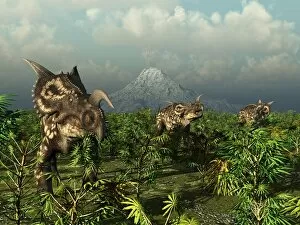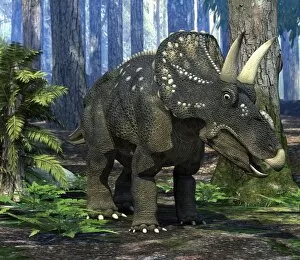Cretaceous Collection (page 65)
The Cretaceous period, a time of great change and evolution, witnessed the last days of the dinosaurs
All Professionally Made to Order for Quick Shipping
The Cretaceous period, a time of great change and evolution, witnessed the last days of the dinosaurs. Amongst them, the mighty Tyrannosaurus rex engaged in their primal ritual of mating, showcasing their power and dominance. Meanwhile, Triceratops roamed the land with their formidable horns as Iguanodons peacefully grazed on vegetation as herbivores. In this illustration from the Cretaceous period, a Segnosaurus can be seen indulging in its leafy feast. This era was marked by continental drifts that occurred around 100 million years ago. The Seven Sisters Chalk Cliffs in East Sussex, England stand tall as remnants of this ancient landscape. As we delve into history through Wealden Times, we witness scenes from this remarkable epoch. Alongside these cliffs lie coastguard cottages at Cuckmere Haven near Seaford - a picturesque reminder of our planet's rich past. Amidst all these wonders emerged unique creatures like Corythosaurus with its distinctive crest and Mosasaurus - an awe-inspiring marine reptile ruling over prehistoric seas. And let us not forget Spinosaurus; towering above others with its sail-like structure on its back. The Cretaceous period holds countless mysteries waiting to be unraveled, and is a chapter in Earth's story that captivates our imagination and reminds us of the incredible diversity that once thrived on our planet's surface.














